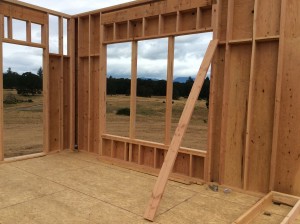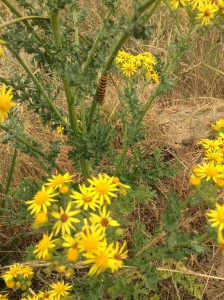“You haven’t posted anything for a while. What’s up?” Larry asks.
“Nothing funny’s happened.”
“Ah. Well, I can only do my best. Why don’t you write about that guy at Kubota who tried to sell me a tractor big enough to mow a hundred acres? That was pretty funny.”
“More like scary, you mean.”
But let’s not talk about that. We’re not going to buy a tractor soon.
The first walls are up on the house. I would love to show you a photo, but since downloading “Yosemite” on my MAC I can no longer add media. Will have to get help somewhere, somehow, as is very annoying. Oh wait, just discovered a work-around. So. Beautiful, huh?
While this was happening, we had a meeting with Jarod Jebousek of USF&W, and with Steve, formerly with same. We sat under the misshapen oak for a couple of hours and talked about what can happen. Jarod seems enthusiastic about working on the wetland portion of the property, and he talked about locating and removing old drainage tile as the first project. This so that the water can defuse across the property instead of channeling. Something F&W would do, of course, not the Viehls. At the end of the discussion we agreed to enter into a 10 year partnership with the agency, during which time they do the work we agree upon, and we agree not to reverse whatever they do.
Meanwhile, Larry and I will take with Mark (Cow Guy) about a proposal to rotate the cows among fields we will fence (courtesy of those good F&W folks). And so get to work on the savanna. The cows are gone, by the way, though the fences remain. Hot? Don’t know, as neither of us cared to find out.
But the tansy! Here’s what I have learned: all parts of the plant are toxic. Death to animals, and danger to humans if there is food chain contamination. Enter the cinnabar moth. The moths emerge from the pupae in May and June, then lay eggs under the emerging leaves of the tansy. Couple of weeks later, the larvae, in the form of caterpillars, emerge. They’re pretty cute, though don’t touch them!
Be sure to click on the photo to get a good look.
They absorb the toxin from the ragwort, and are bright colored as a warning to birds that they are poison. Not all the larvae make the pupal stage, as they consume all the plant material (we hope!) and die of starvation. Perhaps because of hunger, they are also cannibalistic. Also predated by ants, of which we have an abundance, only the lucky form their pupae and go to sleep for the fall, winter, and spring.
So, Larry and I armed ourselves with pruning shears and large paper trash bags, and spent Saturday loping off the heads of whichever plants had no caterpillars on board. The strategy, as described by Jarod and Steve, is to take off the flowers, causing the plant to send up another generation of blossoms, which we’ll remove again in the fall. Theoretically. This generation of seed is weaker, and the plant, theoretically, believes it’s completed its life cycle and dies. Because seeds remain viable in the soil for 15 or so years, it’s tough to control. But we marched around the property, examined the plants, cheered on the evil/good caterpillars, bagged up the fallen flower stalks, and considered it a day well spent.
I know. Not as much fun as seeing a matinee, you’re thinking, or listening to music in a park somewhere, or hiking, or playing golf, or whatever else old people do for amusement. Came home, washed off the dirt and went to a party where we met some neighbors whom we like a lot. A good day, even if neither of us did anything particularly risible. Don’t worry. We go again next Wednesday.



You’re in it to win it. Go big or go home. Don’t back down. Fight to the bitter end. You’re in it for the long haul. Take no prisoners. (Wo)man up. Balls to the wall. Carpe Diem. Hit it hard in the paint.
(These encouraging affirmations courtesy of the interweb…)
“Balls to the wall” indeed! quelle graphic.
“Balls to the wall” indeed! quelle graphic